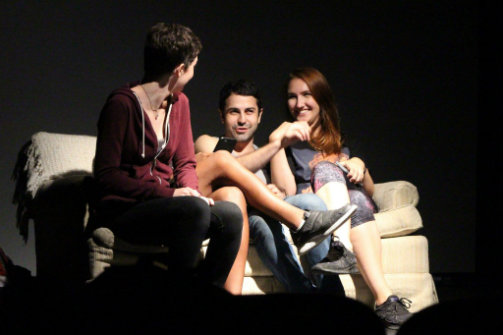Canuck Downunder
By Jessica Kazamel; Directed by Joseph Hayward
Produced by Jessica Kazamel and Joseph Hayward
Part of the 2016 New York International Fringe Festival
Off Off Broadway, Play
Runs through 8.27.16
VENUE #15: SoHo Playhouse, 15 Vandam Street
by Scott Illingworth on 8.22.16
 Haley Sullivan, Alexander Hodge, and Eloise Edwards in Canuck Downunder. Photo by Alexandra Campos.
Haley Sullivan, Alexander Hodge, and Eloise Edwards in Canuck Downunder. Photo by Alexandra Campos.
BOTTOM LINE: Canuck Downunder explores the way technology and grieving intersect when a young Canadian woman tragically loses her brother overseas.
Just before curtain time at Jessica Kazamel’s Canuck Downunder I stood in the bathroom next to a man urinating and checking social media at the same time. In many respects, this is the very heart of what Kazamel confronts in her piece—a culture where even the most intimate and private events are now connected to and adulterated by technology.
The play begins with the discovery that Jess (played sensitively by Haley Sullivan) is mourning the recent death of her brother. Upon her return to New York, she is besieged by a deeply insensitive roommate (Eloise Edwards), a barrage of social media well-wishers and tragedy groupies, and family living back in Canada whose needs just don’t match her own.
Kazamel works to investigate something important here—that we fail one another in these moments of grief because we do not understand what people need, or are too self-involved to see the need at all. Throughout the play, both in the writing and in the performing, the characters miss opportunities or misinterpret attempts to connect. Instead, we see simple cruelty or watch characters knowingly hurt people already in pain without apparent provocation.
Perhaps this is Kazamel’s intent, but there are times when her characters succeed at connecting, and this is what proves more interesting. The best moment of the piece is when Jess calls her mom in the height of a crisis and tries to keep it together as she admits “I want to go home.” Her mother (Anita Rosner) hasn’t been listening well, but hears this plea and tries to somehow meet Jess’s needs despite not giving her exactly what she wants.
Towards the latter half of Canuck Downunder we see more of these connecting moments. Jess and her roommate make an effort to reconnect. She and her other brother struggle together to understand their desire to keep writing their dead sibling messages online. All of these speak to Kazamel’s understanding of the complexities of this kind of life event and how social media can complicate the grieving process.
The program makes clear that the play is autobiographical and it is impossible not to sympathize with Jess as she sorts through her grief alone. The production, however, gives little credit to the people around Jess. They mainly slide into two-dimensionality in service of hurting her and failing her. This undermines the comedy and the heartbreak possible in these relationships. By the time we get a few moments of redemption late in the play it is too late—Jess’s friends don’t feel worth redeeming.
Jess sometimes sits at her computer, looks at his pictures, and writes her deceased brother messages via social media. He is, in these times, very much alive. There is beautiful potential in this idea: the way we live on past ourselves digitally is both cruel and a gift. It's a timely idea, worthy of investigation, and one that you can see the playwright understands and grapples with.
(Canuck Downunder plays at VENUE #15: SoHo Playhouse, 15 Vandam Street, through August 27, 2016. The running time is 1 hour. Performances are Thu 8/18 at 7:30; Sun 8/21 at 5; Tue 8/23 at 5:30; Thu 8/25 at 2; and Sat 8/27 at 7:45. There is no late seating at FringeNYC. Tickets are $18 and are available at fringenyc.org. For more information visit jessicakazamel.com.)
Canuck Downunder is by Jessica Kazamel. Directed by Joseph Hayward. Lighting Design is by Jason Fok. Assistant Stage Manager is Siri Gussiaas.
The cast is Haley Sullivan, Eloise Edwards, Txai Frota, Anita Rosner, Vince Ryne, Brandon Looney, and Alexander Hodge.

